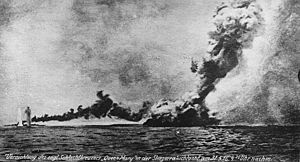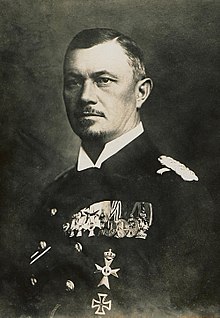Battle of Jutland
Battle of Skagerrak
Part of: World War I (naval warfare)

Explosion of the battle cruiser HMS Queen Mary
Naval Warfare in the North Sea 1914-1918
Heligoland (1914) - 22 September 1914 - Texel - Yarmouth - Scarborough, Hartlepool and Whitby - Cuxhaven - Doggerbank (1915) - Noordhinder Bank - Doggerbank (1916) - 29 February 1916 - Yarmouth and Lowestoft - Skagerrak - 19 August 1916 - Channel (1916) - Canal (1917) - Shetland Islands - Heligoland (1917) - Bergen - Zeebrugge and Ostend - Tondern
The naval battle off Skagerrak was the largest naval battle of World War I between the German High Seas Fleet and the Grand Fleet of the Royal Navy, fought from 31 May 1916 to 1 June 1916 in the waters off Jutland. It is known in English as the Battle of Jutland and was the largest naval battle between capital ships fought mainly in daylight.
The German fleet planned an advance against the merchant shipping on the south coast of Norway in order to track down individual British units such as the battle cruiser squadron. The Skagerrak provided an alternative route of retreat into the Baltic Sea. British intelligence had overheard the German orders and thereupon planned to trap the German fleet between the Grand Fleet and the battlecruiser squadron. On the afternoon of 31 May, the battlecruiser squadrons met. The battle shifted south until it came to a clash with the main German force. The British squadron then turned north to the main British force. Between 7:30 p.m. and nightfall at 9:30 p.m., the two fleets of about 250 ships combined then fought each other. Under cover of darkness, the German fleet managed to break through the British formation and then march back to home ports.
The outcome of the battle is to be judged differentiated: The British suffered significantly higher losses of life and ships, although they led stronger forces into battle. The success of the German side, however, consisted de facto only in having achieved a draw. Moreover, the battle did not change the strategic starting position, which enabled the Royal Navy to maintain the naval blockade until the end of the war, as the German High Seas Fleet no longer dared to fight a decisive battle.
The fleets
| Grand Fleet | High Seas Fleet | |
| Battleships | 28 | 16 |
| Battlecruiser | 9 | 5 |
| Battleship | 8 | - – |
| Older liners | - – | 6 |
| Small cruisers | 26 | 11 |
| Smaller vessels | 80* | 61 |
| Heavy artillery (calibre) | 48 × 38,1 cm10 | 144 × 30,5 cm100 |
| Guns (all calibres) | 1850 | 1194 |
| fired projectiles | 4598 Severity | 3597 Heavy9252 |
| goals scored | 100 Heavy42 | 120 Heavy107 |
| Hit rate (SA only) | 2,17 % | 3,33 % |
| Torpedo tubes | 382 × 53,3 cm75 | 362 × 50 cm107 |
| * 77 destroyers, 1 seaplane mother ship, 1 minelayer, 1 tender | ||
| In addition, 10 German naval airships were deployed for reconnaissance. | ||
German High Seas Fleet
The German fleet commander was Vice Admiral Reinhard Scheer, and the battlecruiser commander was Vice Admiral Franz von Hipper. There were 16 battleships, five battlecruisers, six obsolete pre-dreadnoughts, eleven small cruisers and 61 torpedo boats involved. It should be noted, however, that the German torpedo boats came close to matching the sizes of the British destroyers.
British Grand Fleet
The British fleet commander was Admiral Sir John Jellicoe, who had 99 mostly heavy units in his force. Squadron commander of the battlecruisers was Vice Admiral Sir David Beatty, who commanded 52 units. There were a total of 28 battleships, nine battlecruisers, eight armoured cruisers, 26 light cruisers and 80 other British ships involved.
Important factors
The Grand Fleet was outnumbered about 8:5. The British ships were generally also equipped with larger calibers, which had a higher effective range to boot. The German guns, on the other hand, had a higher muzzle velocity, which increased the stability of the bullet trajectory and the impact energy on the target. The good visibility that prevailed in the late afternoon enabled the British ships to exploit their range advantage and extend the combat range to 14 kilometers. Effective fire control at the time required that one could observe one's own shell impacts in order to correct the alignment of one's guns accordingly. The British fired complete salvos, observed the impacts and then corrected the firing distance by a standard value of 400 yards and fired again. So it could take some time until one could shoot covering (bracket system). The Germans used only three shots, each at a different distance. Their firing in was correspondingly faster (ladder system).
Another advantage would have been the naval airships of the Germans. Admiral Beatty said of this after the battle, "The enemy still has the monopoly of the best air reconnaissance in good weather, where one Zeppelin can do as much as five or six cruisers." However, on May 30, 1916, wind conditions prevented airships from launching, while on May 31, the airships deployed could not get closer than 30 nautical miles to the fleets.
The leadership of the German High Seas Fleet had relied on the generally only moderate visibility - about 7 kilometres - on the North Sea and had equipped the ships built at the same time as British units in each case with somewhat smaller, less long-range guns, in favour of higher rate of fire and full-sized medium artillery. The High Seas Fleet compensated for this disadvantage with more penetrating shells, better range-finding equipment, and better armor and other protection. Consequently, the German hit rate of 3.3% was significantly higher than the British 2.2%. The British were aggravated by the fact that their shells had less penetrating power. They tended to detonate on impact with the armour rather than penetrating it first. In other cases, while they succeeded in penetrating German armor, they were so damaged in the process that they failed to detonate due to their weaker construction. Therefore, while they could cause leaks, they could not endanger the entire ship through fires and secondary explosions.

A division of the 2nd Battleship Squadron of the Grand Fleet: King George V followed by Thunderer, Monarch and Conqueror.
Planning of the German fleet commander
Until January 1916, the German High Seas Fleet, in accordance with its operational orders, behaved defensively in accordance with its inferiority. Individual advances against the British coast by shelling coastal towns remained largely fruitless. When Vice Admiral Scheer replaced Admiral Hugo von Pohl, who had fallen ill, as head of the fleet in January 1916, he obtained permission from the German Kaiser Wilhelm II for more offensive naval warfare.
The plan was to provoke individual British fleet elements by battlecruiser attacks on coastal towns and destroy them with the numerically superior High Seas Fleet waiting in a reception position. This was to be supported by submarines and mines off the British bases. After a balance of forces had thus been achieved, a naval battle was to be brought about between the main forces of the Grand Fleet and the High Seas Fleet.
However, the already prepared fleet advance against the British coast was cancelled due to bad weather, as no aerial reconnaissance by zeppelins could take place. Instead, the German fleet commander decided on a merchant war venture off the Norwegian coast to lure the British from their bases.

German Fleet Commander Vice Admiral Reinhard Scheer
Questions and Answers
Q: What was the Battle of Jutland?
A: The Battle of Jutland was the most important naval battle in World War I.
Q: Why was the German fleet blockaded in WWI?
A: The German fleet was blockaded by the larger Royal Navy in WWI.
Q: Where was the German fleet mostly kept?
A: The German fleet was mostly kept in its base at Wilhelmshaven.
Q: Who led the German fleet during the Battle of Jutland?
A: Admiral Reinhard Scheer led the German fleet during the Battle of Jutland.
Q: What kind of ships did the German fleet consist of during the Battle of Jutland?
A: The German fleet consisted of 22 battleships, five battlecruisers, 11 cruisers and 61 torpedo-boats during the Battle of Jutland.
Q: Where were the main British bases during the Battle of Jutland?
A: The main British bases were in Scotland including the Orkney and Shetland having a huge base at Scapa Flow, and bases on the mainland were at Cromarty on the Moray Firth and at Rosyth on the north bank of the Firth of Forth.
Q: Where was the Battle of Jutland fought?
A: The Battle of Jutland was fought over a wide area at Jutland Bank west of the Skagerrak between Norway and Denmark.
Search within the encyclopedia